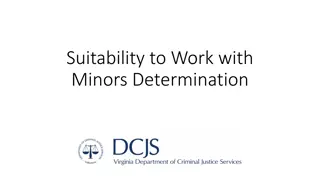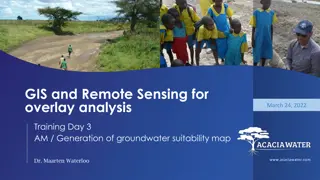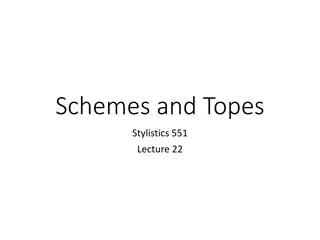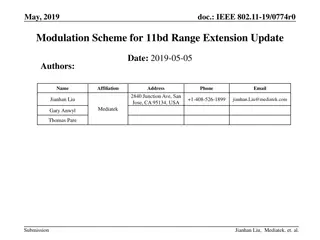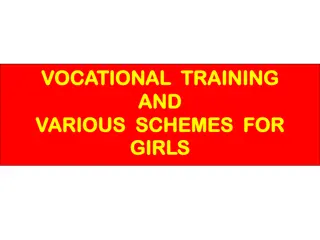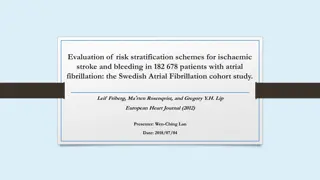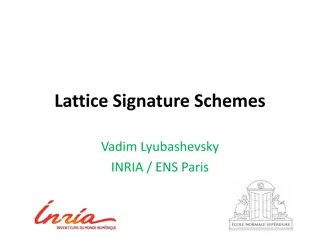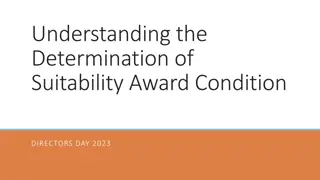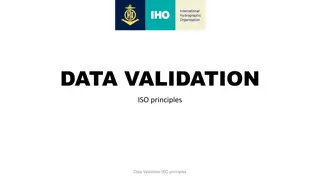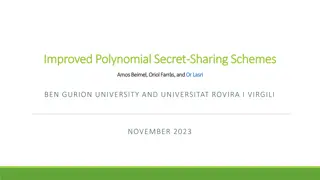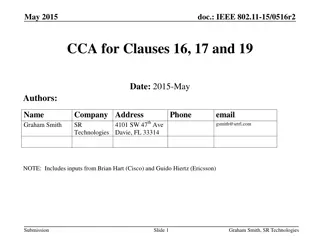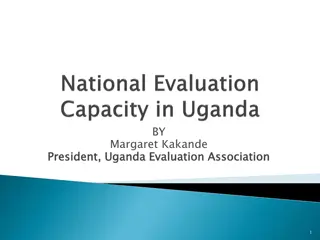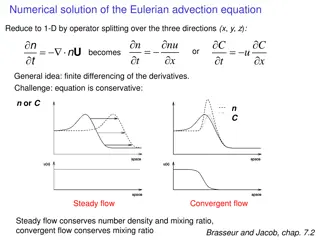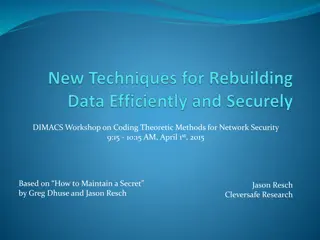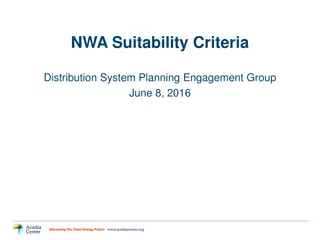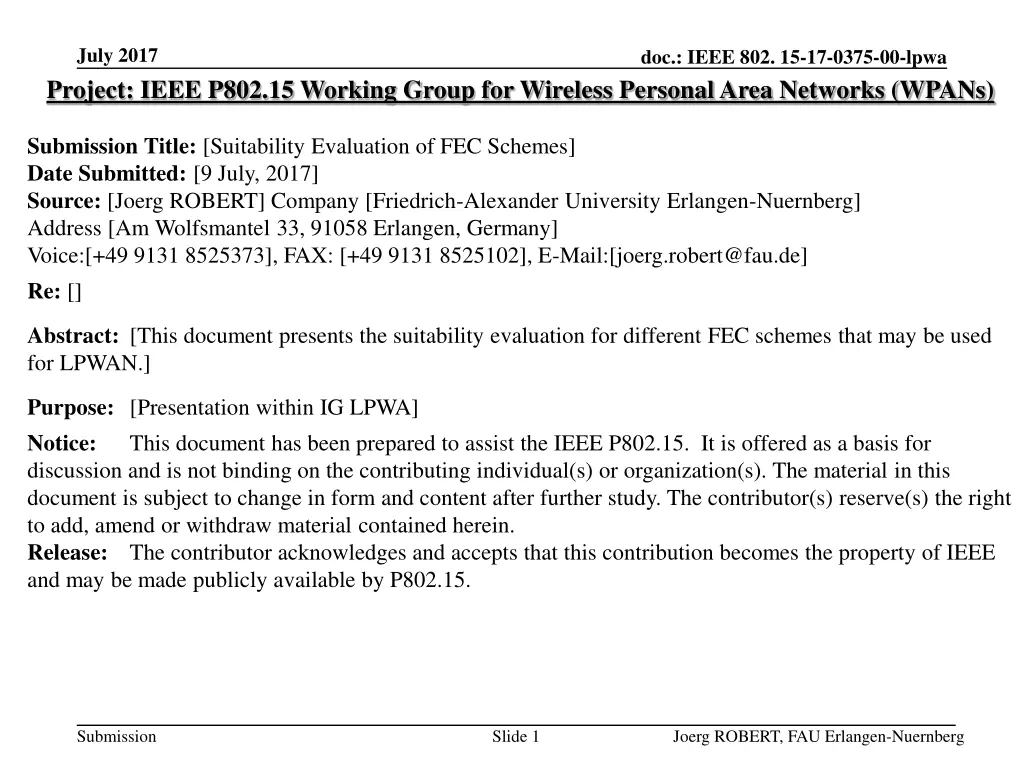
Evaluation of Forward Error Correction Schemes for LPWAN Networks
"This document evaluates the suitability of different Forward Error Correction (FEC) schemes for Low-Power Wide-Area Network (LPWAN) applications. It discusses the pros and cons of various FEC techniques such as Reed Solomon, BCH, and the impact on performance in different scenarios. The evaluation considers factors like data transmission efficiency, error correction capabilities, and suitability for long-range communication. The analysis aims to guide decision-making within the IEEE P802.15 Working Group for Wireless Personal Area Networks (WPANs)."
Download Presentation

Please find below an Image/Link to download the presentation.
The content on the website is provided AS IS for your information and personal use only. It may not be sold, licensed, or shared on other websites without obtaining consent from the author. If you encounter any issues during the download, it is possible that the publisher has removed the file from their server.
You are allowed to download the files provided on this website for personal or commercial use, subject to the condition that they are used lawfully. All files are the property of their respective owners.
The content on the website is provided AS IS for your information and personal use only. It may not be sold, licensed, or shared on other websites without obtaining consent from the author.
E N D
Presentation Transcript
July 2017 Project: IEEE P802.15 Working Group for Wireless Personal Area Networks (WPANs) doc.: IEEE 802. 15-17-0375-00-lpwa Submission Title: [Suitability Evaluation of FEC Schemes] Date Submitted: [9 July, 2017] Source: [Joerg ROBERT] Company [Friedrich-Alexander University Erlangen-Nuernberg] Address [Am Wolfsmantel 33, 91058 Erlangen, Germany] Voice:[+49 9131 8525373], FAX: [+49 9131 8525102], E-Mail:[joerg.robert@fau.de] Re: [] Abstract: [This document presents the suitability evaluation for different FEC schemes that may be used for LPWAN.] Purpose: [Presentation within IG LPWA] Notice: This document has been prepared to assist the IEEE P802.15. It is offered as a basis for discussion and is not binding on the contributing individual(s) or organization(s). The material in this document is subject to change in form and content after further study. The contributor(s) reserve(s) the right to add, amend or withdraw material contained herein. Release: The contributor acknowledges and accepts that this contribution becomes the property of IEEE and may be made publicly available by P802.15. Submission Slide 1 Joerg ROBERT, FAU Erlangen-Nuernberg
July 2017 doc.: IEEE 802. 15-17-0375-00-lpwa Suitability Evaluation of FEC Schemes Joerg Robert, FAU Erlangen- Nuernberg Submission Slide 2 Joerg Robert, FAU Erlangen-Nuernberg
July 2017 doc.: IEEE 802. 15-17-0375-00-lpwa No FEC ( I / II ) Simple transmission of the data without forward error- correcting codes Pros Simple Cons Significant performance loss (> 10dB) wrt. theory Very inefficient for long packets Does not allow for long-range due to low performance Sensitive wrt. interference Submission
July 2017 doc.: IEEE 802. 15-17-0375-00-lpwa No FEC ( II / II ) Channel Model Indoor Outdoor Rural Outdoor Urban Interference Model Dense Medium Low None Active Interfering Users Very High High Medium Low Frequency Regulation ETSI FCC ETSI/FCC None Availability > 90% > 99% > 99.9% Power Supply CR 2025 2xAA Energy Harvesting External Cell Radius > 50km < 50km < 10km < 5km < 1km Node Velocity 3 km/h 30 km/h 120 km/h Data Length <= 16 bytes <= 64 bytes <= 256 bytes > 256 bytes Submission Slide 4 Joerg Robert, FAU Erlangen-Nuernberg
July 2017 doc.: IEEE 802. 15-17-0375-00-lpwa Reed Solomon / BCH ( I / II ) Simple transmission of the data without forward error- correcting codes Pros Relatively Simple Acceptable performance with hard decision data Good performance in case of block errors Cons Significant performance loss wrt. theory Only limited block length available Limited performance in case of bit errors (e.g. AWGN channel) Submission
July 2017 doc.: IEEE 802. 15-17-0375-00-lpwa Reed Solomon / BCH ( II / II ) Channel Model Indoor Outdoor Rural Outdoor Urban Medium Low None > 90% > 99% > 99.9% Power Supply CR 2025 2xAA Energy Harvesting External > 256 bytes Interference Model Dense Active Interfering Users Very High High Medium Low Frequency Regulation ETSI FCC ETSI/FCC None Availability Cell Radius > 50km < 50km < 10km < 5km < 1km Node Velocity 3 km/h 30 km/h 120 km/h Data Length <= 16 bytes <= 64 bytes <= 256 bytes Submission Slide 6 Joerg Robert, FAU Erlangen-Nuernberg
July 2017 doc.: IEEE 802. 15-17-0375-00-lpwa Convolutional Code ( I / II ) Encode the data using convolutional encoder, decoding typically based on Viterbi algorithm Pros Very simple encoding Acceptable decoding performance Good performance in case of bit errors (e.g. AWGN channel) Good performance in case of block errors with interleaver Cons Good performance (close to theoretical limits) only for short block length Requires soft-information for full performance Submission
July 2017 doc.: IEEE 802. 15-17-0375-00-lpwa Convolutional Code ( II / II ) Channel Model Indoor Outdoor Rural Outdoor Urban Medium Low None > 90% > 99% > 99.9% Power Supply CR 2025 2xAA Energy Harvesting External > 256 bytes Interference Model Dense Active Interfering Users Very High High Medium Low Frequency Regulation ETSI FCC ETSI/FCC None Availability Cell Radius > 50km < 50km < 10km < 5km < 1km Node Velocity 3 km/h 30 km/h 120 km/h Data Length <= 16 bytes <= 64 bytes <= 256 bytes Submission Slide 8 Joerg Robert, FAU Erlangen-Nuernberg
July 2017 doc.: IEEE 802. 15-17-0375-00-lpwa Turbo Code ( I / II ) Turbo Codes are based on concatenated convolutional codes with iterative decoding Pros Very simple encoding Good performance in case of bit errors (e.g. AWGN channel) Good performance in case of block errors with interleaver Cons High decoding complexity (only for use in powerful base-station) Requires soft-information for full performance Requires long block lengths for good performance Submission
July 2017 doc.: IEEE 802. 15-17-0375-00-lpwa Turbo Code ( II / II ) Channel Model Indoor Outdoor Rural Outdoor Urban Interference Model Dense Medium Low None Active Interfering Users Very High High Medium Low Frequency Regulation ETSI FCC ETSI/FCC None Availability > 90% > 99% > 99.9% Power Supply CR 2025 2XAA Energy Harvesting External Cell Radius > 50km < 50km < 10km < 5km < 1km Node Velocity 3 km/h 30 km/h 120 km/h Data Length <= 16 bytes <= 64 bytes <= 256 bytes > 256 bytes Submission Slide 10 Joerg Robert, FAU Erlangen-Nuernberg
July 2017 doc.: IEEE 802. 15-17-0375-00-lpwa LDPC Code ( I / II ) Low Density Parity Check (LDPC) Code are based on block codes with spare code matrices Pros Acceptable encoding complexity Good performance in case of bit errors (e.g. AWGN channel) Cons High decoding complexity (only for use in powerful base-station) Requires soft-information for full performance Requires long block lengths for good performance Sensitive wrt. erasures/puncturing (e.g. in case of block fading) Normally fixed block length (inflexible) Submission
July 2017 doc.: IEEE 802. 15-17-0375-00-lpwa LDPC Code ( II / II ) Channel Model Indoor Outdoor Rural Outdoor Urban Interference Model Dense Medium Low None Active Interfering Users Very High High Medium Low Frequency Regulation ETSI FCC ETSI/FCC None Availability > 90% > 99% > 99.9% Power Supply CR 2025 2XAA Energy Harvesting External Cell Radius > 50km < 50km < 10km < 5km < 1km Node Velocity 3 km/h 30 km/h 120 km/h Data Length <= 16 bytes <= 64 bytes <= 256 bytes > 256 bytes Submission Slide 12 Joerg Robert, FAU Erlangen-Nuernberg
July 2017 doc.: IEEE 802. 15-17-0375-00-lpwa Polar Code ( I / II ) New code class for short codes that is currently discussed for 5G for protecting signaling information Pros Very good performance also in case of short block lengths Cons High decoding complexity as special decoder is required (only for use in powerful base-station) Requires soft-information for full performance IPR status unclear Optimized for short block length Submission
July 2017 doc.: IEEE 802. 15-17-0375-00-lpwa Polar Code ( II / II ) Channel Model Indoor Outdoor Rural Outdoor Urban Interference Model Dense Medium Low None Active Interfering Users Very High High Medium Low Frequency Regulation ETSI FCC ETSI/FCC None Availability > 90% > 99% > 99.9% Power Supply CR 2025 2XAA Energy Harvesting External Cell Radius > 50km < 50km < 10km < 5km < 1km Node Velocity 3 km/h 30 km/h 120 km/h Data Length <= 16 bytes <= 64 bytes <= 256 bytes > 256 bytes Submission Slide 14 Joerg Robert, FAU Erlangen-Nuernberg
July 2017 doc.: IEEE 802. 15-17-0375-00-lpwa Any Questions or Comments? Submission Slide 15 Joerg Robert, FAU Erlangen-Nuernberg

